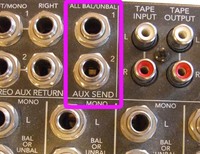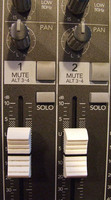Audio to the Boom Operator
 In this example, we plug the output for the boomperson's headphones into the main Aux Send 1, which is a ¼-inch jack. Use a ¼-plug to XLR male adapter cable, and then run an XLR mic cable back to the boom operator. At the boom operator's end, there is a ¼-inch jack to XLR female adapter (or belt box), to accommodate headphones.
In this example, we plug the output for the boomperson's headphones into the main Aux Send 1, which is a ¼-inch jack. Use a ¼-plug to XLR male adapter cable, and then run an XLR mic cable back to the boom operator. At the boom operator's end, there is a ¼-inch jack to XLR female adapter (or belt box), to accommodate headphones.
Usually, the ¼-inch Aux Output jack is wired for monaural. You may need a simple mono-stereo adapter so that the boomperson is able to hear in both sides of the headphones.
Note that on some mixing panels, you might use Aux 2 for the boomperson -- if Aux 2 is normally preset for Post Fader and Aux 1 for Pre Fader. It varies depending on what make and model board you use.
Some of the more expensive boards even offer a dedicated output with volume control for the boomperson.
If you are not sure whether or not an Aux output is set to pre or post fader, it is simple enough to determine. Just plug your headphones into the Aux output jack, and then slide down the mix fader. If you hear the decrease in your headphones, you are plugged into Post Fader. But if the mic does not change even though you adjusted the fader, then you are listening to Pre Fader.
On a professional set, we use a custom duplex cable that does the same thing in a neater package. At the mixer end are two XLR connectors -- one to carry the audio from the boompole and another to send a headphone feed back to the boomperson. Both audio lines are packaged in a single housing, so there is only one physical cable linking the boom to the mixer. At the boom operator's end there is a breakout box that includes an XLR female connector (for the boom mic) and a headphone jack. Some boxes even have a volume control for the headphones. These cables are anywhere from 50 to 100 feet long, with 75 being the most popular length.
It is also possible to use a radio mic or wireless assistive listening device to transmit audio back to the boom operator.
If the sound mixer is monitoring out of a backup digital recorder, then you could plug the boom operator into the regular headphone jack of the mix panel.
Pan
The last knob on the input strip is the Pan pot, which sends the signal to the left, right, or anywhere in between. Use it to assign the input signal to a specific track if you are recording in stereo (2-track).
 If you are only recording in monaural, in other words, only sending one audio track to your camera, then leave the PAN pot in the center. That way, the exact same audio will be assigned and output to the Left and Right tracks of your mixer, and you can hear in both sides of your headphones.
If you are only recording in monaural, in other words, only sending one audio track to your camera, then leave the PAN pot in the center. That way, the exact same audio will be assigned and output to the Left and Right tracks of your mixer, and you can hear in both sides of your headphones.
If you are recording onto a 2-track recorder, then it is better to assign your inputs to complete left or right, but not a centered mix of both at the same time. Otherwise, you cannot deal with the 2 audio tracks separately during post.
Forget the terms 'left" and 'right". They only exist for the post-production mix. Instead, think of your mixer as being able to output two DIFFERENT monaural feeds, so that your editor has the most flexibility in cutting tracks. Later on, those tracks will be re-mixed or assigned to left and right (or more likely, to 5.1 which is: Center, Front Left, Front Right, Surround Left, Surround Right, and Sub-woofer).
Remember back at the beginning of this article when we mentioned the stereo line level input strips? This is the time to explain them. For starters, there is no mic pre-amp (trim pot). The only control for setting the ballpark level is a button that lets you adjust the line level sensitivity from professional plus 4 to prosumer minus 10. Both are "line level" signals; but plus 4 is somewhat hotter than minus 10. Just try the button either way and go with whatever gets you a decent volume (the wrong setting would be either way too strong or way too weak).
If you had one line level source plugged in to a strip, then the pan control would work similar to that on a monaural (XLR) strip. It would route the audio to track one, track two, or anywhere in between.
When you plug two line level sources into one of these "stereo strips," the strip detects the presence of both plugs and changes into a 'stereo" mode. Any volume and EQ settings affect both input signals (such as the left and right sides of a music track). The pan knob changes into a 'volume balance" control that lets you make one side louder or softer than the other, but does not pan the sound from one side to another.
